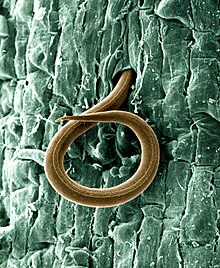Meloidogyne incognita: Difference between revisions
m Task 3: +{{Taxonbar|from=Q628493}} (2 sig. taxon IDs); WP:GenFixes, using AWB |
→top: bold, rm overlink |
||
| Line 8: | Line 8: | ||
| ordo = [[Tylenchida]] |
| ordo = [[Tylenchida]] |
||
| familia = [[Heteroderidae]] |
| familia = [[Heteroderidae]] |
||
| genus = ''[[Meloidogyne]]''''' |
| genus = '''''[[Meloidogyne]]''''' |
||
| species = '''''M. incognita''''' |
| species = '''''M. incognita''''' |
||
| binomial = ''Meloidogyne incognita'' |
| binomial = ''Meloidogyne incognita'' |
||
| Line 14: | Line 14: | ||
}} |
}} |
||
'''''Meloidogyne incognita''''' is a species of [[nematode]]s (roundworms) in the [[Family (biology)|family]] [[Heteroderidae]]. It is commonly called the "southern root-knot |
'''''Meloidogyne incognita''''' is a species of [[nematode]]s (roundworms) in the [[Family (biology)|family]] [[Heteroderidae]]. It is commonly called the "'''southern root-knot nematode'''" or the "'''cotton root-knot nematode'''". This parasitic roundworm has worldwide distribution and numerous [[host (biology)|hosts]]. It is an important [[parasite|plant parasite]] classified in [[parasitology]] as a [[root-knot nematode]], as it prefers to attack the root of its host plant. |
||
When ''M. incognita'' attacks the roots of plants, it sets up a feeding location, where it deforms, (destroys) the normal root cells and establishes giant cells. The roots become gnarled or nodulated (knobbly, rough, and twisted), forming [[gall]]s, hence the term "root-knot" nematode. |
When ''M. incognita'' attacks the roots of plants, it sets up a feeding location, where it deforms, (destroys) the normal root cells and establishes giant cells. The roots become gnarled or nodulated (knobbly, rough, and twisted), forming [[gall]]s, hence the term "root-knot" nematode. |
||
Revision as of 00:02, 4 June 2018
| Meloidogyne incognita | |
|---|---|

| |
| Scientific classification | |
| Kingdom: | |
| Phylum: | |
| Class: | |
| Order: | |
| Family: | |
| Genus: | |
| Species: | M. incognita
|
| Binomial name | |
| Meloidogyne incognita | |
Meloidogyne incognita is a species of nematodes (roundworms) in the family Heteroderidae. It is commonly called the "southern root-knot nematode" or the "cotton root-knot nematode". This parasitic roundworm has worldwide distribution and numerous hosts. It is an important plant parasite classified in parasitology as a root-knot nematode, as it prefers to attack the root of its host plant.
When M. incognita attacks the roots of plants, it sets up a feeding location, where it deforms, (destroys) the normal root cells and establishes giant cells. The roots become gnarled or nodulated (knobbly, rough, and twisted), forming galls, hence the term "root-knot" nematode.
M. incognita has been found to be able to move along shallower temperature gradients (0.001C/cm) than any other known organism,[1] an example of thermotaxis. The response is complicated and thought to allow the nematodes to move toward an appropriate level in soil,[2] while they search for chemical cues that can guide them to specific roots.[3][4][5]
The life cycle has four juvenile stages and four moults (shed, cast).
See also
References
- ^ Pline, Diez, and Dusenbery, J. Nematology, 20:605-608 (1988). Extremely sensitive thermotaxis of the nematode Meloidogyne incognita.
- ^ Dusenbery, D.B. Biological Cybernetics, 60:431-437 (1989). A simple animal can use a complex stimulus pattern to find a location,
- ^ Pline and Dusenbery. 1987. Responses of the plant-parasitic nematode Meloidogyne incognita to carbon dioxide determined by video camera-computer tracking. J. Chem. Ecol. 13 : 873-888.
- ^ Dusenbery. 1987. Theoretical range over which bacteria and nematodes locate plant roots using carbon dioxide. J. Chem. Ecol. 13 : 1617-1624.
- ^ Diez and Dusenbery. 1989. Repellent of root-knot nematodes from exudate of host roots. J. Chem. Ecol. 15:2445-2455.
- Lamberti, Franco and Taylor, Charles Edwin (eds.) (1979) Root-knot nematodes (Meloidogyne species): systematics, biology and control Academic Press, New York, ISBN 0-12-434850-5 ;
- Diez, J. A., and Dusenbery, D. B. (1989) "Preferred temperature of Meloidogyne incognita" Journal of Nematology 21: pp. 99–104;
- McCarter, James P. et al. (2003) "Analysis and functional classification of transcripts from the nematode Meloidogyne incognita" Genome Biology 4: R26, doi:10.1186/gb-2003-4-4-r26
